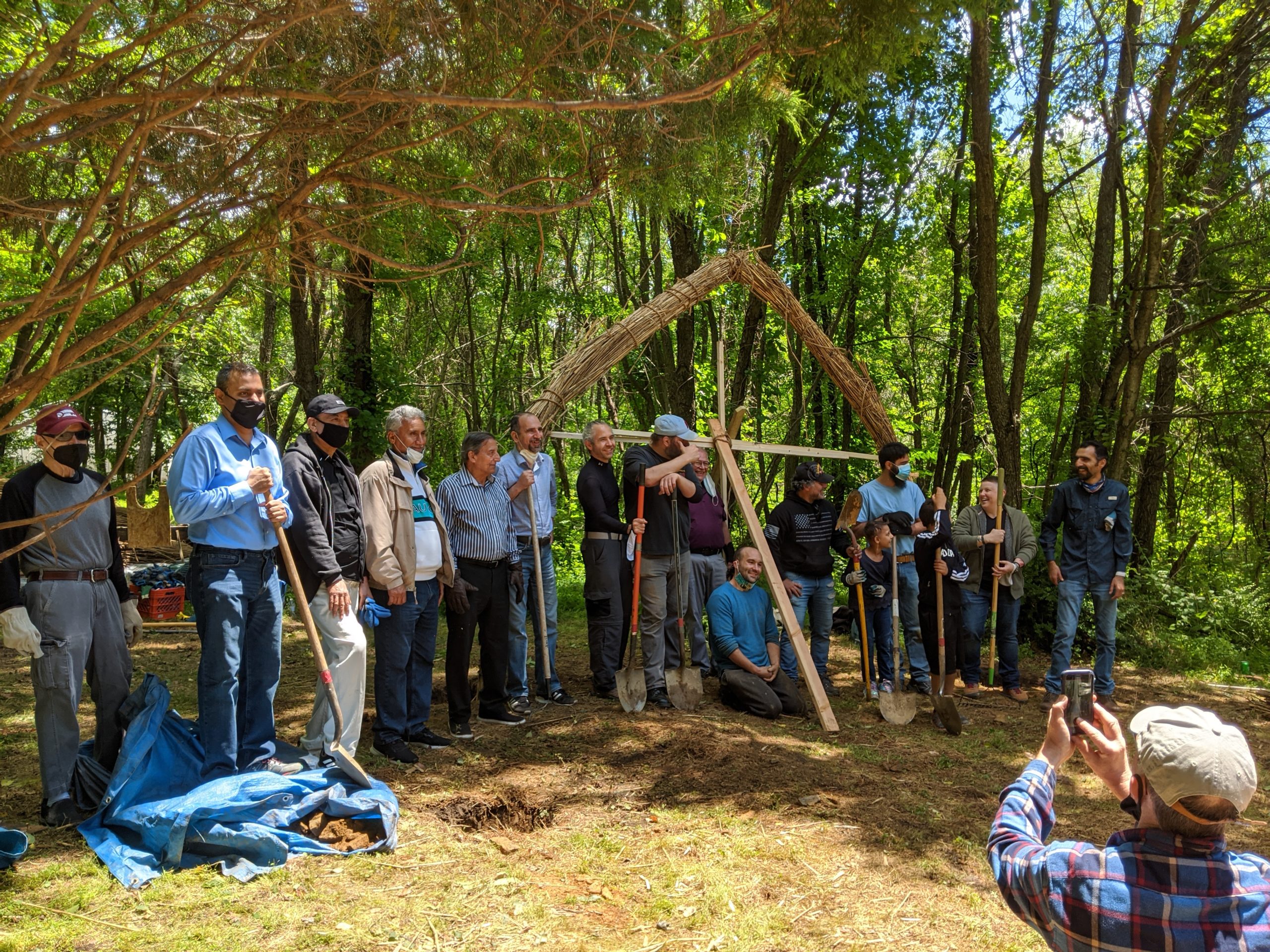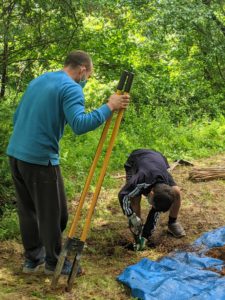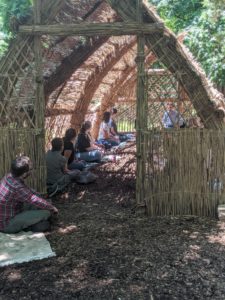At-one-ment and Soul Healing

“God has made known to us the mystery of God’s will, according to God’s good pleasure (delight) set forth in Christ, as a plan for the fullness of time, to unite all things in him, things in heaven and things on earth.” –Ephesians 1:9-10
“Atonement is the path I step into so that my identity is congruent with my life.” — Glen Miller
I looked across the dozen or so feet that separated us. There, an Iraq war veteran who has borne the soul wounds of war for more than a decade was digging a posthole with a ten-year-old Iraqi boy. I beheld the scene in awe and deep emotion. The veteran, a man of strength and sensitivity, had been devastated when he was part of an operation where dozens of civilians had been killed in an airstrike. The victims had included a number of young children.
On Memorial Day of this year, I was privileged to join with U.S, war veterans and Iraqi civilians in a special project at the Schuylkill Center for Environmental Education in Roxborough. We were coming together in the construction of a mudhif, a traditional Iraqi guest house made of marsh reeds. Crafted in care-ful partnership, the mudhif was being built to serve as a gathering place to share personal experiences of war with one another through storytelling, deep listening, and journeys of mutual healing. Many of the veterans were carrying inner wounds of war– moral injuries–from their experiences. The Iraqis were civilians directly impacted by the same war, having been displaced from their homeland and enduring unspeakable losses. My friend Chris, a Unitarian pastor, VA Chaplain, and Afghanistan war veteran, offered the opening invocation for the groundbreaking of the project. He called forth veterans and Iraqi citizens together, beckoning them to place their hands one atop another on a digging bar which would be driven into the soil. He invited them, as they did so, to call out the name of someone whose memory they were reverencing on this Memorial Day. Names of loved ones and comrades filled the air; one of the Iraqi participants exclaimed “half my family.”
I watched the veteran and the boy working in partnership, so disarmed and so beautiful. And it was an honor to be in this place where those who had fought and those who suffered war’s devastating effects were together and were building a sanctuary for others on this holy ground.

The Letter to the Ephesians is quite a remarkable text for these times. It talks about the world’s violence and the peace of Christ as starkly as any New Testament book. It calls the faith community to live out the gospel of Christ’s peace right here in the world. It promises the bringing together of God’s people across all boundaries! It declares that God’s transformative intention is nothing less than the abolishment of enmity and the real-ization of God’s reign.
I have been a psychotherapist, a local church pastor, a prison chaplain, a mission partner with communities in Central America, and a peace educator. In recent years, my calling in ministry has increasingly been in tending the soul wounds of war. These “moral injuries” are manifestations of deep moral pain incurred from violating one’s core moral beliefs or having those beliefs shattered. Experiences of killing, wounding others, death of civilians, violating the dignity of vulnerable human beings, instances of torture and mistreatment, the abuse of human remains, failure to protect others and prevent injury– these are among the experiences that violate the human soul. Realizing that the motivations and goals of war are far different than what both citizens and service people have been disingenuously told by our leaders, and being ordered by superiors to act in unethical ways, can lead to deep feelings of betrayal. Indeed, I have heard many veteran stories that intensely repeat evidence of killing and moral harm that range far beyond defending the people of America. These feelings of betrayal can be intensified when returning veterans encounter the moral disengagement of the populace that sent them into war and an unwillingness to receive the often difficult truths of their experience, with little interest shown in tending to their pain. Loss of trust, collapse of key systems of meaning, the apparent absence or venality of God, a sense of unworthiness or being beyond forgiveness, a profound sense of having lost themselves or died spiritually: all mark the territory. Additionally there is the horrifying epidemic of veteran suicides–in recent decades the numbers of warriors killed in military service is dwarfed by those lost to suicide (killed after action)–before which we stand stupefied and silent.
Let’s be clear: moral injury is not a disorder. Quite the opposite. As Bret Litz articulates so eloquently: “Anguish, guilt, and shame are signs of an intact conscience and self-and-other expectations about goodness, humanity, and justice (Litz,et al, p. 704).” Our nation needs more of those things! Ethicist Joe Wiinikka-Lydon refers to moral injury as “burdensome knowledge embodied that concerns one’s self and one’s culture and society.” Wiinikka-Lydon recognizes the prophetic role that such veterans are empowered in, and the life-giving role that they can yet play in calling forth the conscience of a society long lost in war-making and denial:
“In some cases, such experiential knowledge can and should inform a politically engaged, social ethic. This may help some of the morally injured to live into this new knowledge, and so help in living with such an “injury,” by engaging society with an ethic rooted in and formed from critical reflection on their felt experience of war. Such engagement can be important, both for veterans, many of whom struggle to find forums where the challenging content of their experiences will be heard, as well as for the larger society, whose members have neither directly witnessed the real ramifications of their country’s foreign policy nor been present to feel those policy consequences bodily.” (Wiinikka-Lydon, p.2)
The difficult beauty of this dynamic is that the people of American communities must draw close to tend to our wounded sons and daughters and reclaim our covenantal relationship with them. Some of the veterans who were present in the building of the mudhif were those who had participated in twelve-week Moral Injury Groups at the Crescenz VA Medical Center in Philadelphia and had become leaders among the veterans’ community (http://www.scheerpost.com/2021/08/04/moral-injury-and-the-forever-wars/#comments ). They were among those who began relating directly to Iraqi citizens who had found refuge in the Philadelphia area. Part of their healing journey in the MIG involved participating in a Community Healing Ceremony where they shared their testimonies of war and its wounds with civilians gathered in the chapel at the VA. As part of the ceremony itself, veterans and civilians join together in a deeply meaningful ritual. The ritual begins with civilians gathered in the center of a protective circle of veterans. The two groups are then beckoned to turn face-to-face and to move in a manner where each civilian makes eye contact with each veteran. Then they change places, with the civilians marking the veterans’ homecoming by forming a protective circle around them, offering words of fresh commitment to the veterans: ” We put you into situations where atrocities were possible. We share responsibility with you for all you have seen, for all you have done, and for all you have failed to do.” Everyone will now share the difficult truths and burdens of war. The terrible isolation that many veterans have experienced begins to be bridged. And the civilians express the vulnerable willingness to be changed by what is shared with them.
This kind of authentic encounter and relationship building must take place beyond the walls of the VA. Christian faith communities are particularly situated and prepared for an active role in tending the wounds of war, repenting the moral disengagement of the civilian population from the impact of our wars on our service people and the citizens of other lands, and being part of an emerging future rooted in the peace of Christ rather than the endless cycles of war. We answer to a higher authority, and draw on a power much greater than our own.
The Letter to the Ephesians is stirring in its clarity: “For Christ is our peace; the one making two groups into one and breaking down the dividing (bearing) wall, the enmity, having abolished in his flesh and blood the law of commandments and ordinances, that he might create in himself one new humanity, thus making peace (Ephesians 2:14-15).” This message of atonement, at-one-ment, is one of healing, not sacrifice. Jesus did not die on the cross to satisfy God’s wrath or pay the debt for human sin; rather that “he might reconcile both groups to God in one body, through the cross, putting to death the enmity, the hostility, through it. (v. 16)” Death–the infliction of it, wielding of it, threat of it–would never have the last word again. Jesus would take the Living, embodied Word of God’s love for all people deeply into the realm of death, that the power of God’s saving love would be that which will overcome death in all its forms and fulfill God’s will: “to unify all things in Christ (1:9).” One new humanity will be created where there have been violent divisions, dividing walls, dehumanizing “laws of the land” and imperial edicts, fears of getting too close to the pain of others or assuming responsibility for mending that which has been broken in pieces. Let us ponder this message as we behold soul-wounded veteran and Iraqi child; warriors and victims of war joining as one; civilians repenting moral disengagement and vowing not to betray the trust of sons and daughters again. At-one-ment celebrated in humble and powerful ways.
There is an eschatological hope in these beautiful, deeply human scenes. Ephesians has identified enmity between God’s children as the antithesis of God’s will. But we have been living in a world that understands itself through division. Human identity is constantly measured over and against one another. We always need enemies. Someone must be sacrificed or expelled to bring about “peace.” Death is worshiped as the ultimate power. Endless war becomes the backbone of worldly economies. Human imagination is distorted such that there is no vision of the future that does not require violence to be fulfilled, even among followers of Jesus! War sacrifice is conflated with Jesus’ giving of his life on the cross, the greatest of virtues. Yet the deep truths of war experience, the “burdensome knowledge,” is kept at a distance here at home. According to Ephesians, such division has been the bearing wall that has kept the cultural house we live in in from collapsing.
But Christians commit to following Jesus, who calls himself the “Son of Humanity” (the True Human), and who comes to collapse that bearing wall, dismantling the system of violence and death’s infliction in order to create a new humanity in his way of being. “Follow me,” he proclaims, into a life of giving (love of God and neighbor inexplicably intertwined) where we are freed to love the way God loves, discover the image of God in the one who has been “other,” and where the embrace of God’s love is not limited by religious group or geographical location or privilege or grip of empire or the unholy power of might. “So he came and proclaimed peace to you who were far away and peace to those who were near; for through him both of us have access in one Spirit to the Father; so you are no longer strangers and aliens but you are citizens with the saints and also members of the household of God, built upon the foundation of apostles and prophets, with Jesus himself as the cornerstone. In him the whole structure is joined together and grows into a holy temple in the Lord, in whom you also are built together spiritually into a dwelling place for God (2:17-22).” This new house will replace the old one! In this same spirit, biblical scholar Ched Myers refers to the church as “the called out community which inherits the messianic vocation of peacemaking (Myers, p. 30).” We inherit the way of being that constantly breaks cycles of violence and diminishment and recognizes the image of God in all people.
About fifteen years ago a veteran in the congregation I was serving–an army medic who was deployed in Desert Storm in 1991– and I set out to explore what it would mean to be a church that not only welcomed veterans but also the fullness of their stories and their experiences. He himself shared his poignant testimony with the congregation: of being the first generation of his family born in the United States. of being proud to serve in the military, about how formative his experiences remain today. He also talked of humanizing the Iraqi “enemy”; he was moved when he encountered prisoners of war and saw them as much like himself, weary of war and eager to go home. He also spoke of how he viewed his training in retrospect; how his training dehumanized the “other” in order to make it easier to kill them. He recited marching chants from basic training, including, “Napalm sticks to kids.” As his faith journey deepened, he now grappled honestly with whether or not one can be a committed follower of Jesus and also a soldier at the same time. His vulnerability and integrity were disarming. A couple of years later, a member of the congregation in his late eighties, who had served in the army in World War II and had fought in Okinawa, asked me to come to his house. He wanted to talk to me about the first Japanese soldiers he killed in battle. He wasn’t conflicted about what he felt he had to do in hand-to-hand combat. But he was impacted by their humanity. He had kept pieces of their uniforms and a family picture from one man’s wallet. Nearly seventy years later, he had not forgotten them. I gave thanks to God for this reverence.
Over time, our Veterans Ministry Team connected with the Veterans Community Network in our neighboring county. We joined together in forming COMPASS (Circles Offering Mindful Participation and Safe Spaces): Healing Circles that include veterans, veteran family members, and members of the wider community (including church members) that we call “stronghearts.” Here a sanctuary for storytelling and the honoring of truth is established; capacity for deep listening is developed; community is built; forgiveness and atonement (for all) are engaged; accompaniment and fidelity are practiced; and the journeys of healing from wars wounds and divisions are made together. I will write a second blog post about COMPASS. But for now, you may be interested in this: http://www.closeencountersinwar.org/2021/04/11/short-article-about-veteran-healing-strong-hearts-by-glen-miller-and-scott-hutchinson/ .
My dear friend Glen Miller, a Vietnam veteran of 38 combat missions, a professor of ethics, and partner in our healing circle work, has spoken vividly about the importance of acts of atonement (at-one-ment) in his own healing from the inner wounds of war. Glen has said that it has been in acts of atonement that he has begun to experience forgiveness, rather than the other way around. We are talking about acts of repair that bring the separated, the broken, the divided, back into union. Glen says, “Atonement is a path I step into so that my identity is congruent with my life.” His words resonate with the proclamation of peace in Ephesians.

The completed mudhif, filled with children of God: a here-and-now embodiment of the house God is building?
The apostolic voice from Ephesians, spoken from an empire jail cell, invites us to the territory of transformation: “I, therefore, the prisoner (“bound one”) in the Lord, beg you to lead a life worthy of the calling to which you have been called, with all humility and gentleness, with patience, bearing with one another in love, making every effort to maintain the unity of the Spirit in the bond of peace” (Ephesians 4:1-3). The bond of peace being a very different kind of “bond”: one that paradoxically sets us free!
Sources:
Litz, B. et al (2009). “Moral Injury and Moral Repair: A Preliminary Model for Intervention and Study.” Clinical Psychology Review 29(8): 695-706.
Myers, C. (1986). “The Cross and the Cold War: The Ephesian Gospel of Peace.” Sojourners 15(10): 28-31.
Wiinikka-Lydon, J. (2016). “Moral Injury as Inherent Political Critique: The Prophetic Possibilities of a New Term.” Political Theology, 1-14.
